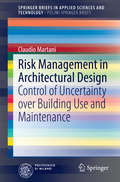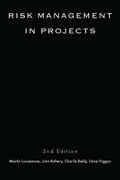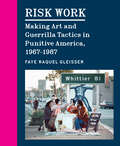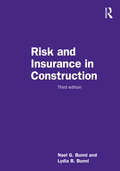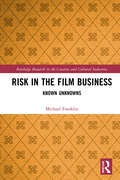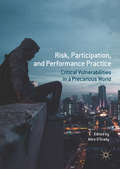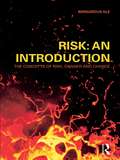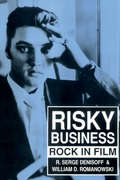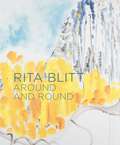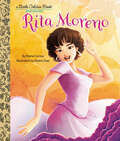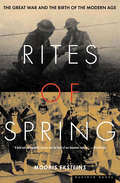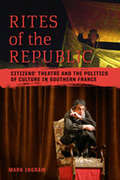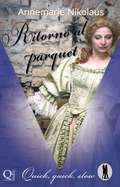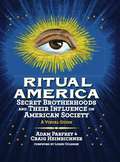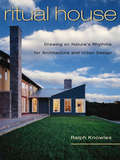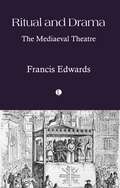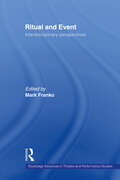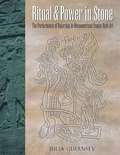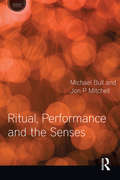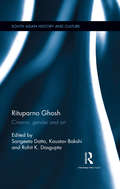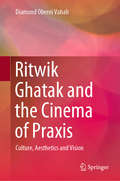- Table View
- List View
Risk Avoidance for the Building Team
by Basil SawczukRisk avoidance has to be addressed not only at the outset of any building project but throughout its lifespan and by all parties involved in the contract. This book covers each stage of the construction process in turn and examines potential problem areas from the point of view of each of the three main parties involved: employer, consultant and contractor. By a thorough examination of each topic covered, using checklists, suggested agendas, briefing notes, risk assessment charts etc., the author has provided: * a practical guide on how to react to many difficult situations which arise * strong focus on risk avoidance techniques and how to apply them * a balanced approach, looking at problems from all sides to promote understanding of adversaries' viewpoints.
Risk Management in Architectural Design
by Claudio MartaniThis book analyzes the risk management process in relation to building design and operation and on this basis proposes a method and a set of tools that will improve the planning and evaluation of design solutions in order to control risks in the operation and management phase. Particular attention is paid to the relationship between design choices and the long-term performance of buildings in meeting requirements expressing user and client needs. A risk dashboard is presented as a risk measurement framework that identifies and addresses areas of uncertainty surrounding the satisfaction of particularly relevant requirements over time. This risk dashboard will assist both designers and clients. It will support designers by enabling them to improve the maintainability of project performance and will aid clients both in devising a brief that emphasizes the most relevant aspects of maintainability and in evaluating project proposals according to long-term risks. The results of assessment of the proposed method and tools in tests run on a number of buildings of worship are also reported.
Risk Management in Projects
by Martin Loosemore David Higgon John Raftery Charles ReillyProject managers in construction and civil engineering need to base their decisions on realistic information about risk and public perceptions of risk. This second edition of the original practical and straightforward text retains the easy-to-read format, but has been expanded to encompass the entire risk management process and to give a fuller presentation of how risk is generally perceived. Two new chapters cover risk identification and risk response, and the chapters on risk analysis have been completely reorganized. There is also greater emphasis on the theory behind the principles, and an expanded bibliography is given to guide an exploration of the subject in greater detail. The book demystifies risk management by presenting the subject in simple and practical terms, free of technical jargon, and case studies are used extensively to enliven the text and to illustrate the concepts discussed.
Risk Work: Making Art and Guerrilla Tactics in Punitive America, 1967–1987
by Faye Raquel GleisserHow artists in the US starting in the 1960s came to use guerrilla tactics in performance and conceptual art, maneuvering policing, racism, and surveillance. As US news covered anticolonialist resistance abroad and urban rebellions at home, and as politicians mobilized the perceived threat of “guerrilla warfare” to justify increased police presence nationwide, artists across the country began adopting guerrilla tactics in performance and conceptual art. Risk Work tells the story of how artists’ experimentation with physical and psychological interference from the late 1960s through the late 1980s reveals the complex and enduring relationship between contemporary art, state power, and policing. Focusing on instances of arrest or potential arrest in art by Chris Burden, Adrian Piper, Jean Toche, Tehching Hsieh, Pope.L, the Guerrilla Girls, Asco, and PESTS, Faye Raquel Gleisser analyzes the gendered, sexualized, and racial politics of risk-taking that are overlooked in prevailing, white-centered narratives of American art. Drawing on art history and sociology as well as performance, prison, and Black studies, Gleisser argues that artists’ anticipation of state-sanctioned violence invokes the concept of “punitive literacy,” a collectively formed understanding of how to protect oneself and others in a carceral society.
Risk and Insurance in Construction
by Nael G. Bunni Lydia B. BunniThe new 3rd edition of Nael Bunni’s Risk and Insurance in Construction, now co-authored with Lydia Bunni, explains the need for insurance in construction and engineering projects and why it must be incorporated into the Conditions of Contract for such projects. It is unique in bringing together the background of the two topics of 'risk' and 'construction insurance', explaining the flow and the interaction between them and then dealing with how they have been used to formulate the 2017 FIDIC Suite of Contracts and the 2021 Green Book. This edition has been fully updated, and new chapters deal with the latest definitions of 'risk' outlined in ISO 31000: 2009, and specifically explains the principles embodied in the new Clauses 17, 18 and 19 of the Major Suite of the FIDIC forms of contract and how they should be used. An important chapter (Chapter 5) is included, discussing the logical transition from decision-making to risk identification to responsibility for those allocated with particular risks, to the potential liability that results. This includes discussing particular liabilities that may arise for parties typically involved in construction and engineering projects, including developers, owners, contractors and designers. This part of the book links insurance to the law and explains the interaction between the two topics. The correlation between liability and the need for indemnity, which can only be provided properly through insurance, is highlighted. The book is essential reading for practitioners from both the engineering profession and the insurance industry in all types of projects. Engineers who are required to use one of the Major Forms of the FIDIC Suite of Contracts, whether they are designers or contractors, and those involved in the insurance sector, whether brokers, claim consultants or insurance company personnel, will find this book to be an indispensable reference.
Risk in the Film Business: Known Unknowns (Routledge Research in the Creative and Cultural Industries)
by Michael FranklinThis book explores the complex, multifaceted and contested subject of risk in the film business. How risk is understood and managed has a substantial impact upon which films are financed, produced and seen. Founded on substantial original research accessing the highest level of industry practitioners, this book examines the intertwined activity of independents, large media companies including major studios, the international marketplace, and related audio-visual sectors such as high-end television. The book shows how risk is generally framed, or even intuited, rather than calculated, and that this process occurs across a sliding scale of formality. This work goes beyond broad creative industries characterisations of a "risky sector" and concentrations on Box Office return modelling, to provide a missing middle. This means a coherent analytic coverage of business organisation and project construction to address the complex practicalities that mobilise strategic operations in relation to risk, often in unseen business-to-business contexts. Informed by economic sociology’s concepts addressing market assemblage and valuation, alongside applications of science and technology studies to media and communications, the book respects both the powerful roles of social and institutional actors, and affordances of new technologies in dealing with the persistent known unknown – the audience. Examining a persistent business issue in a new way, this book analyses top level industry practice through established mechanisms, and innovations like data analytics. The result is a book that will be essential reading for scholars with an interest in the film business as well as risk management more broadly.
Risk, Participation, and Performance Practice: Critical Vulnerabilities in a Precarious World
by Alice O'GradyThis book explores a range of contemporary performance practices that engage spectators physically and emotionally through active engagement and critical involvement. It considers how risk has been re-configured, re-presented and re-packaged for new audiences with a thirst for performances that promote, encourage and embrace risky encounters in a variety of forms. The collection brings together established voices on performance and risk research and draws them into conversation with next generation academic-practitioners in a dynamic reappraisal of what it means to risk oneself through the act of making and participating in performance practice. It takes into account the work of other performance scholars for whom risk and precarity are central concerns, but seeks to move the debate forwards in response to a rapidly changing world where risk is higher on the political, economic and cultural agenda than ever before.
Risk: The Concepts of Risk, Danger and Chance
by Ben AleInvestments, global warming and crossing the road – risk is a factor embedded in our everyday lives but do we really understand what it means, how it is quantified and how decisions are made? In six chapters Ben Ale explains the concepts, methods and procedures for risk analysis and in doing so provides an introductory understanding of risk perception, assessment and management. Aided by over seventy illustrations, the author casts light on the often overlooked basics of this fascinating field, making this an essential text for students at undergraduate and postgraduate level as well as policy and decision-making professionals. Developed from the Safety Science or Risk Science course taught at Delft University, this highly respected author has a lifetime of knowledge and experience in the study of risk.
Risky Business: Rock in Film
by William D. RomanowskiThe role of motion pictures in the popularity of rock music became increasingly significant in the latter twentieth century. Rock music and its interaction with film is the subject of this significant book that re-examines and extends Serge Denisoff's pioneering observations of this relationship.Prior to Saturday Night Fever rock music had a limited role in the motion picture business. That movie's success, and the success of its soundtrack, began to change the silver screen. In 1983, with Flashdance, the situation drastically evolved and by 1984, ten soundtracks, many in the pop/rock genre, were certified platinum. Choosing which rock scores to discuss in this book was a challenging task. The authors made selections from seminal films such as The Graduate, Easy Rider, American Grafitti, Saturday Night Fever, Help!, and Dirty Dancing. However, many productions of the period are significant not because of their success, but because of their box office and record store failures.Risky Business chronicles the interaction of two major mediums of mass culture in the latter twentieth century. This book is essential for those interested in communications, popular culture, and social change.
Rita Blitt: Around and Round
by Mulvane Art MuseumRita Blitt: Around and Round is a full-color, beautifully produced collection of works by internationally renowned artist Rita Blitt. The works gathered in these pages are selections from Rita Blitt's output from 1958 to the present and are representative of her many mediums—painting, drawing, sculpture, video, and interdisciplinary collaboration. Blitt&’s words &“Kindness is contagious. Catch it!&” have inspired thousands of people all over the world. Her works are included in numerous museums, installations, and private collections—including those in Australia, Israel, Japan, Singapore, and the United States. Her short film collaboration with David Parsons, Parsons Dance Company, and Lois Greenfield, entitled "Caught in Paint," has won 16 awards and has been invited to be shown in over 130 film festivals. This collection of art and scholarly essays is published in commemoration of the establishment of Washburn University's Rita Blitt Legacy Collection. In 2019, she was awarded an Honorary Doctoral degree in Fine Arts by Washburn University.
Rita Moreno: A Little Golden Book Biography (Little Golden Book)
by Maria CorreaHelp your little one dream big with a Little Golden Book biographyabout EGOT-winning actor, singer, and dancer, Rita Moreno. Little Golden Book biographies are the perfect introduction to nonfiction for young readers!This Little Golden Book about Rita Moreno—Puerto Rican-born star of West Side Story and the first Latina to win an Oscar—is an inspiring read-aloud for young children, as well as their parents and grandparents who are fans.Look for more Little Golden Book biographies: • Betty White • Carol Burnett • Lucille Ball • Harry Belafonte • Julie Andrews • Dwayne Johnson
Rites of Spring: The Great War and the Birth of the Modern Age
by Modris EksteinsThis award-winning cultural history reveals how the Great War changed humanity. This sweeping volume probes the origins, the impact, and the aftermath of World War I—from the premiere of Igor Stravinsky&’s ballet The Rite of Spring in 1913 to the death of Hitler in 1945. &“The Great War,&” as Modris Eksteins writes, &“was the psychological turning point . . . for modernism as a whole. The urge to create and the urge to destroy had changed places.&” In this &“bold and fertile book&” (The Atlantic Monthly), Eksteins goes on to chart the seismic shifts in human consciousness brought about by this great cataclysm, through the lives and words of ordinary people, works of literature, and such events as Lindbergh&’s transatlantic flight and the publication of the first modern bestseller, All Quiet on the Western Front. Rites of Spring is a rare and remarkable work, a cultural history that redefines the way we look at our past—and toward our future.
Rites of the Republic: Citizens' Theatre And The Politics Of Culture In Southern France (Teaching Culture: Utp Ethnographies For The Classroom Ser.)
by Mark IngramIn this fascinating exploration of citizenship and the politics of culture in contemporary France, Ingram examines two theatre troupes in Provence: one based in a small town in the rural part of the Vaucluse region, and the other an urban project in Marseille, France's most culturally diverse city. Both troupes are committed to explicitly civic goals in the tradition of citizens' theatre. Focusing on the personal stories of the theatre artists in these two troupes, and the continuities between their narratives, their performances, and the national discourse directed by the Ministry of Culture, Ingram examines the ways in which these artists interpret universalistic ideals underlying both art and the Republic in their theatrical work. In the process he charts the evolution of new models for society and citizenship in a rapidly changing France.
Ritorno al parquet. Quick, quick, slow (Quick, quick, slow - Club di Danza Lietzensee #3)
by Annemarie Nikolaus Ilaria IgieniPer la prima volta dopo sedici anni Friederike osa tornare sul parquet: un grave incidente d'auto l'aveva costretta ad abbandonare il ballo da sala. La danza è invece diventata il suo argomento di ricerca e ha fatto carriera come professoressa di storia. Un collega diventa il suo nuovo compagno di ballo, poiché suo marito George non vuole prendere parte a un semplice gruppo di ballo come un dilettante: non sarebbe all'altezza della sua carica di presidente del Club di Danza Lietzensee. Tuttavia la sostiene quando lei vuole girare un film sulle danze del barocco con gli square dancer e la formazione latina del circolo. Ma d'un tratto vuole ballare personalmente le danze barocche con lei. Friederike si trova davanti a un dilemma: dall'incidente si era augurata di poter ballare di nuovo con suo marito. Però non vuole neanche deludere il suo collega. Troverà una scappatoia che non offenda nessuno dei due? Il romanzo appartiene alla serie "Quick, quick, slow - Club di Danza Lietzensee", scritta da più autrici. Ogni libro della serie è un romanzo a sé e può essere letto indipendentemente dagli altri.
Ritual America
by Adam Parfrey Craig Heimbichner"Adam Parfrey is one of the nation's most provocative publishers."--Seattle Weekly "Secret society historian Craig Heimbichner follows the Middle Path to wisdom. He works the graveyard shift in the secret lodge."--Joan d'Arc, Paranoia magazine Secret societies--now a staple of bestseller novels--are pictured as sinister cults that use hooded albinos to menace truth-seekers. Some conspiracy books claim that fraternal orders are the work of serpentine aliens and interbred humans who wish to supplant earth of its energy, and later, its very existence. On the other side of the aisle, books by high-ranked Freemasons--skeptical in tone but no less partisan in approach--protect their organization's public image by denying the existence of its most contentious ideas. Ritual America reveals the biggest secret of them all: that the influence of fraternal brotherhoods on this country is vast, fundamental, and hidden in plain view. In the early twentieth century, as many as one-third of America belonged to a secret society. And though fezzes and tiny car parades are almost a thing of the past, the Gnostic beliefs of Masonic orders are now so much a part of the American mind that the surrounding pomp and circumstance has become faintly unnecessary. The authors of Ritual America contextualize hundreds of rare and many never-before printed images with entertaining and far-reaching commentary, making an esoteric subject provocative, exciting, and approachable. Adam Parfrey is the author of Cult Rapture: Revelations of the Apocalyptic Mind and It's a Man's World: Men's Adventure Magazines, the Postwar Pulps. He is editor of the influential Apocalypse Culture series Love, Sex, Fear Death: The Inside Story of the Process Church of the Final Judgment. Craig Heimbichner has recently appeared on a National Geographic documentary about the Bohemian Grove, contributed to the Feral House compilation Secret and Suppressed II, and wrote about the famous occult order the O.T.O. in Blood and Altar.
Ritual House: Drawing on Nature's Rhythms for Architecture and Urban Design
by Ralph KnowlesCelebrated architect Ralph Knowles, Distinguished Emeritus at USC's School of Architecture, has carefully crafted a book for architects, designers, planners--anyone who yearns to reconnect to the natural world through the built environment. He shows us how to re-examine a shadow, a wall, a window, a landscape, as they respond to the natural cycles of heat, light, wind, and rain. Analyzing methods of sheltering that range from a Berber tent to a Spanish courtyard to the cityscape of contemporary Los Angeles, Ritual House shows us the future: by coining the concept of solar access zoning, he introduces a radical yet increasingly viable solution for tomorrow's mega-cities.
Ritual and Drama: The Mediaeval Theatre
by Francis EdwardsIn Ritual and Drama: The Mediaeval Theatre, Francis Edwards reveals that ritual forms the basis of all popular theatrical entertainment, the root from which dramatic art has grown. Covering the period from the tenth to the fifteenth centuries, Edwards focusses on the audience impact rather than the artistic qualities of the mediaeval plays, devoting much of his attention to the emotional effect of religious and dramatic ritual on the spectator. Illuminating the impact of Christian rituals, liturgy, and stories, Edwards draws illustrative parallels between mediaeval and modern states of mind. Ritual and Drama describes the growth of the dramatic idea, the styles of presentation of the mystery cycles, and the evolution of the morality play, presenting in straightforward terms a theme fundamental to our understanding of mediaeval dramatic art.
Ritual and Event: Interdisciplinary Perspectives (Routledge Advances in Theatre & Performance Studies)
by Mark FrankoRitual today can be encountered in the midst of catastrophic and transforming events. This collection reassesses and revises traditionally understood relationships between ritual and politics, ritual and everyday life, ritual and art making, and ritual and disaster. The methodologies as well as the subject matter are interdisciplinary: they range from the anthropological to the art and dance historical, from the theatrical and literary to the linguistic, philosophical, and psychoanalytic. It will be a valuable tool for scholars of Theater and Performance Studies, as well as Anthropology, Art, and History.
Ritual and Power in Stone: The Performance of Rulership in Mesoamerican Izapan Style Art
by Julia GuernseyThe ancient Mesoamerican city of Izapa in Chiapas, Mexico, is renowned for its extensive collection of elaborate stone stelae and altars, which were carved during the Late Preclassic period (300 BC-AD 250). <P><P>Many of these monuments depict kings garbed in the costume and persona of a bird, a well-known avian deity who had great significance for the Maya and other cultures in adjacent regions. This Izapan style of carving and kingly representation appears at numerous sites across the Pacific slope and piedmont of Mexico and Guatemala, making it possible to trace political and economic corridors of communication during the Late Preclassic period.
Ritual, Performance and the Senses (Sensory Studies)
by Michael BullRitual has long been a central concept in anthropological theories of religious transmission. Ritual, Performance and the Senses offers a new understanding of how ritual enables religious representations – ideas, beliefs, values – to be shared among participants. Focusing on the body and the experiential nature of ritual, the book brings together insights from three distinct areas of study: cognitive/neuroanthropology, performance studies and the anthropology of the senses. Eight chapters by scholars from each of these sub-disciplines investigate different aspects of embodied religious practice, ranging from philosophical discussions of belief to explorations of the biological processes taking place in the brain itself. Case studies range from miracles and visionary activity in Catholic Malta to meditative practices in theatrical performance and include three pilgrimage sites: the Church of the Holy Sepulchre in Jerusalem, the festival of Ramlila in Ramnagar, India and the mountain shrine of the Lord of the Shiny Snow in Andean Peru.Understanding ritual allows us to understand processes at the very centre of human social life and humanity itself, making this an invaluable text for students and scholars in anthropology, cognitive science, performance studies and religious studies.
Rituals of Rented Island: Object Theater, Loft Performance, and the New Psychodrama―Manhattan, 1970–1980
by Jay Sanders with J. HobermanIn this important volume, Jay Sanders and J. Hoberman explore the vibrant underground performance art scene of 1970s New York. Focusing on little-known and long-forgotten works, which were often performed in live/work lofts, storefronts, and alternative spaces of the city’s SoHo district, often for an audience comprising a handful of fellow artists, this catalogue makes newly visible a critical period in the development of performance art. Rituals of Rented Island examines the disparate yet related practices of twenty artists, including Stuart Sherman; collaborators Yvonne Rainer and Babette Mangotle; Julia Heyward; Jill Kroesen; Richard Foreman; Squat Theatre; composer-musician John Zorn; and legendary playwright and filmmaker Jack Smith; among others. With an array of previously unpublished images, including installation photographs, scripts, handwritten notes, and other ephemera, drawn from the artists’ own archives, this volume illuminates the eccentric singularities of the performance art of this era and its relevance today.
Rituparno Ghosh: Cinema, gender and art (South Asian History and Culture)
by Rohit K. Dasgupta Sangeeta Datta Kaustav BakshiAn iconic filmmaker and inheritor of the legendary Satyajit Ray’s legacy, Rituparno Ghosh was one of the finest auteurs to emerge out of contemporary Bengal. His films, though rooted firmly in middle-class values, desires and aspirations, are highly critical of hetero-patriarchal power structures. From the very outset, Ghosh displayed a strong feminist sensibility which later evolved into radical queer politics. This volume analyses his films, his craft, his stardom and his contribution to sexual identity politics. In this first scholarly study undertaken on Rituparno Ghosh, the essays discuss the cultural import of his work within the dynamics of a rapidly evolving film industry in Bengal and more largely the cinematic landscape of India. The anthology also contains a conversation section (interviews with the filmmaker and with industry cast and crew) drawing a critical and personal portrait of this remarkable filmmaker.
Ritwik Ghatak and the Cinema of Praxis: Culture, Aesthetics and Vision
by Diamond Oberoi VahaliIn a significant departure from other works on Ritwik Ghatak, this book establishes him as an auteur and a maestro on par with some of the great film directors, like Sergei Eisenstein, Satyajit Ray, Ingmar Bergman, Federico Fellini, Kenji Mizoguchi and Luis Bunuel. Based on in-depth research that follows Ghatak’s journey within the context of the Indian People’s Theatre Association, it fills an important gap in the scholarship around Ghatak by offering crucial insights into Ghatak’s unique vision of cinema embedded as it is in the cultural psychic configurations of the people. It analyses Ghatak’s practice by minutely tracing formal similarities across the language of his cinematic oeuvre in the domain of cinematography, lighting, music, and sound. The book develops the way in which cinematic technique enters the domain of conceptual constructs and abstractions. It moves on to chronicle Ghatak’s political odyssey as reflected in his cinema. Moreover, it charts the manner in which Ghatak, through his cinematic idiom, offers a polemic of cinema that further adds to his notion of praxis – a thoughtful Marxist paradigm organically associated with the culture and context of India. By locating Ghatak within the discourse of nationalism, the book brings to the surface Ghatak’s critical insights related to the independence of the nation and the trauma of the partition of Bengal. Ghatak’s cinema served the crucial function of chronicling the mass tragedy of partition and its impact on the human psyche.This book appeals to scholars of film studies and filmmaking as well as to researchers and general readers interested in debates pertaining to culture, politics, art, psychoanalysis, partition and refugee studies, cinema, theatre, and ideology.
River Boy
by Tim BowlerShe didn't know how fast the current was moving her. It could take many more hours yet, perhaps more hours than she had the strength for. But she must not stop. She must keep going. She must try to catch the river boy, even though she was frightened at the thought of what he was. Jess's beloved grandfather has just had a serious heart attack, but he insists that the family travel as planned to his boyhood home on the river so that he can finish his painting, River Boy. As Jess helps her ailing grandpa with his work, she becomes entranced by the scene he is painting. Then she becomes aware of a strange presence in the river -- a boy who asks for her help and issues a challenge that will stretch her swimming talents to their very limit. Jess knows that Grandpa and the river boy are connected, but how? Can she take up the river boy's challenge before it's too late for Grandpa? Tim Bowler's gripping narrative flows like a river itself -- gentle and calm at times, turbulent and deep at others, always fluid, always alive. Readers will be swept along by the magic of the river and the mysterious river boy -- and changed forever by Jess's unforgettable journey.
River Cities in Asia: Waterways in Urban Development and History (Asian Cities)
by Rita Padawangi Paul Rabé Adrian PerkasaRiver Cities in Asia uncovers the intimate relationship between rivers and cities in Asia from a multi-disciplinary perspective in the humanities and the social sciences. As rivers have shaped human settlement patterns, economies, culture and rituals, so too have humans impacted the flow and health of rivers. In Asia, the sheer scale of urbanization increases the urgency of addressing challenges facing urban rivers, leading to the importance of historically, socially, and culturally relevant solutions. However, cities are also uneven landscapes of power, affecting chances to achieve holistic ecological approaches. The central premise of River Cities in Asia is that a “river city” is one where proximity between a river and a city exists across time and space, natural and social dimensions. Recognition of these deep connections can help to better contextualize policy solutions aimed at rivers and their ecologies, including human life.

